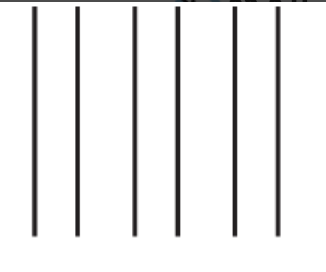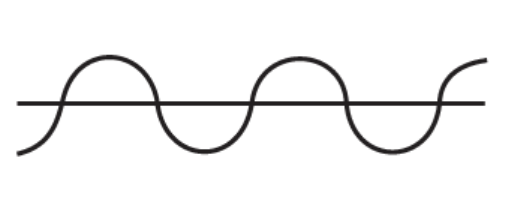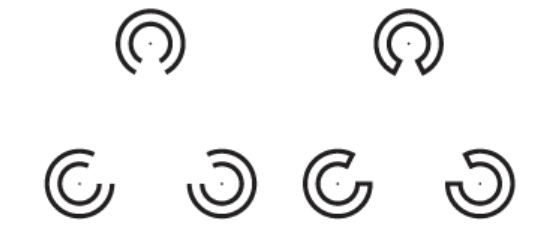Psych Unit 7
1/105
There's no tags or description
Looks like no tags are added yet.
Name | Mastery | Learn | Test | Matching | Spaced |
|---|
No study sessions yet.
106 Terms
sensation
the process by which our sensory receptors and nervous system receive and represent stimulus energies from our environment
sensory receptors
sensory nerve endings that respond to stimuli
perception
the process of organizing and interpreting sensory information, enabling us to recognize meaningful objects and events
brings meaning to sensation; produces an interpretation of the world, but it isn’t a perfect representation
bottom-up processing
analysis that begins with the sensory receptors and works up to the brain’s integration of sensory information (relying on senses ONLY)
top-down processing
information processing guided by higher-level mental processes, as when we construct perceptions drawing on our experience and expectations
reading your friend’s text with a lot of typos and knowing what it means
selective attention
the focusing of conscious awareness on a particular stimulus (minute detail)
cocktail party effect
the ability to attend to one voice among a sea of other voices (while also being able to detect your own name)
inattentional blindness
failing to see visible objects when our attention is directed elsewhere
change blindness
failing to notice changes in the environment; a form of inattentional blindness
transduction
conversion of one form of energy into another; the transforming of stimulus energies, such as sights, sounds, and smells, into neural impulses our brain can interpret
receive: sensory neurons (receptors)
transform: interneurons (processed by brain and spinal cord)
deliver: motor neurons (physiological response)
absolute threshold
the minimum stimulus energy needed to detect a particular stimulus 50% of the time
because there is a fuzzy line between detection and nondetection, a person’s threshold is not necessarily absolute; it varies continuously with our mental alertness and physical condition (signal detection theory)
signal detection theory
a theory predicting how and when we detect the presence of a faint stimulus (signal) amid background stimulation (noise); assumes there is no single absolute threshold and that detection depends partly on a person’s experience, expectations, motivation, and alertness
says sensation depends on the characteristics of the stimulus, background, and detector
takes observer’s characteristics into account, says stimulus judgment is often unconscious
some people can detect certain things more easily than others
subliminal
below one’s absolute threshold for conscious awareness
difference threshold (just noticeable threshold)
the minimum difference between 2 stimuli required for detection 50% of the time (minimum that is still recognizable)
priming
activates unconscious associations; used by researches
Weber’s law
the principle that, to be perceived as different, two stimuli must differ by a constant minimum percentage (rather than a constant amount)
the size of the just-noticeable difference is proportional to the intensity of the stimulus; the just-noticeable difference is large when the intesntiy of the stimulus is high
sensory adaptation
diminished sensitivity as a consequence of constant stimulation
wavelength
the distance from the peak of one light or sound wave to the peak of the next; electromagnetic ones vary from the short blips of gamma rays to the long pulses of radio transmission
hue
the dimension of color that is determined by the wavelength of light; what we know as the color names blue, green, and so forth
intensity
the amount of energy in a light wave or sound wave, which influences what we perceive as brightness or loudness; determined by the wave’s amplitude
cornea
the eye’s clear, protective outer layer, covering the pupil and iris; transparent tissue where light enters the eye
pupil
the adjustable opening in the center of the eye through which light enters
iris
a ring of muscle tissue that forms the colored portion of the eye around the pupil and controls the size of the pupil opening; expands and contracts to change the size of the pupil for light
lens
the transparent structure behind the pupil that changes shape to help focus images on the retina; focuses the light rays on the retina through accommodation
retina
the light-sensitive inner surface of the eye, containing the receptor rods and cones plus layers of neurons that begin the processing of visual information
fovea
the central focal point in the retina, around which the eye’s cones cluster; area of sharpest vision; has highest concentration of cones (NO RODS)
accommodation
the process by which the eye’s lens changes shape to focus near or fear objects on the retina
rods
retinal receptors that detect black, white, and gray, and are sensitive to movement; necessary for peripheral and twilight vision, when cones don’t respond
especially sensitive to dim light, but not color
cones
retinal receptors that are concentrated near the center of the retina and that function in daylight or in well-lit conditions; detect fine detail and give rise to color sensations
especially sensitive to colors, but not dim light
responsible for our ability to “see” colors
path light travels
rods/cones (retina)
bipolar cells
ganglion cells
optic nerve
thalamus
occipital lobe
optic nerve
the nerve that carries neural impulses from the retina to the brain
this is where the stimulus, once changed into a neural impulse, gets passed onto the brain
blind spot
the point at which the optic nerve leaves the eye, creating a “blind” spot because no photoreceptors are located there
Young-Helmholtz trichromatic theory
the theory that the retina contains 3 types of color receptors—one most sensitive to red, one to green, one to blue—which, when stimulated in combination, can produce the perception of any color
opponent-process theory
the theory that opposing retinal processes (red-green, blue-yellow, white-black) enable color vision; for example, some cells are stimulated by green and inhibited by red; others are stimulated by red and inhibited by green
there are some color combos we never see (e.g. reddish-green or yellowish-blue)
color perception is controlled by the activity of 2 opponent systems; a blue-yellow mechanism and a red-green mechanism
feature detectors
nerve cells in the brain’s visual cortex that respond to specific features of the stimulus, such as shape, angle or movement
parallel processing
processing many aspects of a problem simultaneously; the brain’s natural mode of information processing for many functions
audition
the sense or act of hearing
amplitude
the physical strength of a wave (the “volume” of the sound)
frequency
the number of complete wavelengths that pass a point in a given time (determines pitch)
pitch
a tone’s experienced highness or lowness; depends on frequency
decibels
a logarithmic unuit that expresses the ratio of acoustic or electric power (intensity)
eardrum
middle ear
the chamber between the eardrum and cochlea containing 3 tiny bones (hammer, anvil, and stirrup) that concentrate the vibrations of the eardrum on the cochlea’s oval window
cochlea
a coiled, bony, fluid-filled tube in the inner ear; sound waves traveling through the cochlear fluid trigger nerve impulses
contains auditory receptors for hearing
inner ear
the innermost part of the ear, containing the cochlea, semicircular canals, and vestibular sacs
basilar membrane
hair cells
auditory nerve
auditory cortex
sensorineural hearing loss
hearing loss caused by damage to the cochlea’s receptor cells or to the auditory nerves; the most common form of hearing loss
conduction hearing loss
hearing loss caused by damage to the mechanical system that conducts sound waves to the cochlea; less common
cochlear implant
a device for converting sounds into electrical signals and stimulating the auditory nerve through electrodes threaded into the cochlea
tactile sense
sense of touch
bottom-up cognition of pain
top-down cognition of pain
gate-control theory
the theory that the spinal cord contains a neurological “gate” that blocks pain signals or allows them to pass on to the brain; the “gate” is opened by the activity of pain signals traveling up small nerve fibers and is closed by activity in larger fibers or by information coming from the brain
phantom limb sensation
misinterpretation of the spontaneous central nervous system activity that occurs in the absence of normal sensory input
endorphins
placebo
gustation
sense of taste
specialized nerves carry nothing but the taste messages to the brain; there, taste is realized on a specialized region of the parietal lobe’s somatosensory cortex
taste receptors can easily be damaged by alcohol, smoke, acids, or hot foods
gustatory receptors are frequently replaced
olfaction
sense of smell
odons first interact with receptor proteins associated with hairs in the nose
hairs convey information to the brain’s olfactory bulbs, located on the underside of the brain (bypasses thalamus)
kinesthesia
our movement sense—our system for sensing the position and movement of individual body arts
vestibular sense
our sense of body movement and position that enables our sense of balance
receptors for this info are tiny hairs in the semicircular canal of the inner ear (info sent to the cerebellum)
sensory interaction
the principle that one sense may influence another, as when the smell of food influences its taste
McGurk effect
embodied cognition
gestalt
an organized whole; these psychologists emphasized our tendency to integrate pieces of information into meaningful wholes
divides perceptual experience into figure and ground
figure-ground
the organization of the visual field into objects (figures) that stand out from their surroundings (ground)
grouping
the perceptual tendency to organize stimuli into coherent groups
after distinguishing the figure from the ground, our perception needs to organize the figure into a meaningful form using grouping rules
proximity
we group nearby figures together; we see not six separate lines, but three sets of two lines

continuity
we perceive smooth, continuous patterns rather than discontinuous ones; this pattern could be a series of alternating semicircles, but we perceive it as two continuous lines—one wavy, one straight

closure
we fill in gaps to create a complete, whole object, thus we assume that the circles on the left are complete but partially blocked by the (illusory) triangle; add nothing more than little line segments to close off the circles and your brain stops constructing a triangle
both visual and auditory stimuli
similarity, proximity, continuity

depth perception
the ability to see objects in 3 dimensions although the images that strike the retina are 2-dimensional; allows us to judge distance
visual cliff
a laboratory device for testing depth perception in infants and young animals
binocular cues
a depth cue, such as retinal disparity, that depends on the use of two eyes
retinal disparity
a binocular cue for perceiving depth; by comparing retinal images from the 2 eyes, the brain computes distance — the greater the disparity between the 2 images, the closer the object
monocular cues
a depth cue, such as interposition or linear perspective, available to each eye alone
relative height
monocular cue; we perceive objects higher in our field of vision as farther away
relative motion
monocular cue; as we move, objects that are actually stable may appear to move
relative size
monocular cue; if we assume 2 objects are similar in size, most people perceive the one that casts the smaller retinal image as farther away
linear perspective
monocular cue; parallel lines appear to meet in the distance (the sharper the angle of convergence, the greater the perceived distance)
interposition
monocular cue; if one object partially blocks our view of another, we perceive it as closer
light and shadow
monocular cue; shading produces a sense of depth consistent with our assumption that light comes from above
motion perception
the process of inferring the speed and direction of elements in a scene based on visual input
stroboscopic movement
our brain perceiving a rapid series of slightly varying images as continuous movement
phi phenomenon
an illusion of movement created when 2 or more adjacent lights blink on and off in quick succession
perceptual constancy
the ability to recognize the same object as remaining “constant” under changing conditions
color constancy
perceiving familiar objects as having consistent color even when changing illumination filters the light reflected by the object
lightness constancy
ability to perceive the relative reflectance of objects despite changes in illumination
relative luminance
the amount of light a objects reflects on its surroundings
shape constancy
the tendency for a familiar object's shape to be perceived as constant when observed from various angles, positions and orientations
size constancy
the perception of an object or quality as constant even though our sensation of the object changes
perceptual adaptation
the ability to adjust to changed sensory input, including an artificially displaced or even inverted visual field
perceptual set
a mental predisposition to perceive one thing and not another
schema
concepts in our brain that organize and interpret unfamiliar information
context
the situation/circumstances in which an event occurs
extrasensory perception (ESP)
the controversial claim that perception can occur apart from sensory input
telepathy
mind-to-mind communication
clairvoyance
perceiving remote events, such as a house on fire in another state
precognition
perceiving future events, such as an unexpected death in the next moth